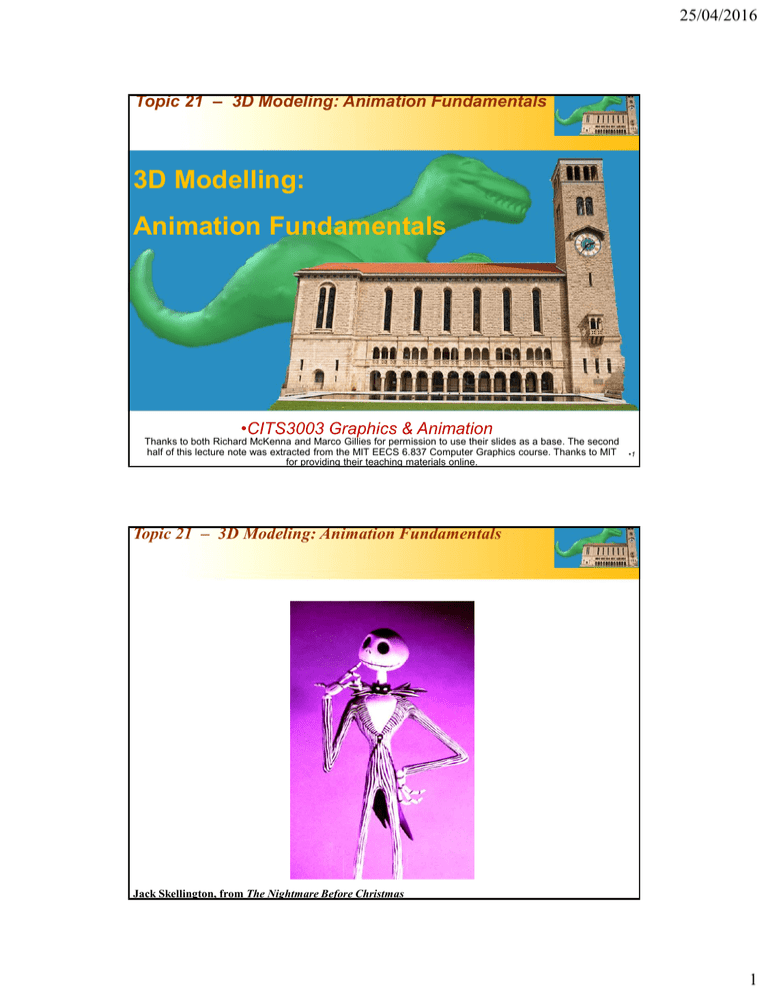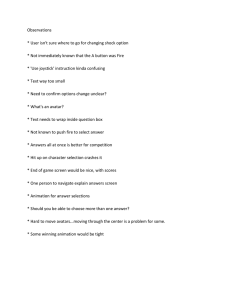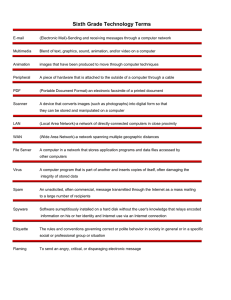
25/04/2016
Topic 21 – 3D Modeling: Animation Fundamentals
3D Modelling:
Animation Fundamentals
•CITS3003 Graphics & Animation
Thanks to both Richard McKenna and Marco Gillies for permission to use their slides as a base. The second
half of this lecture note was extracted from the MIT EECS 6.837 Computer Graphics course. Thanks to MIT
for providing their teaching materials online.
•1
Topic 21 – 3D Modeling: Animation Fundamentals
Jack Skellington, from The Nightmare Before Christmas
1
25/04/2016
Topic 21 – 3D Modeling: Animation Fundamentals
Static objects are boring
• Look at your project part 1 scene objects
– they just sit there
– we can move them to other places and alter the rotation and colour,
but they’re still pretty boring
• What about more complicated & interesting shapes?
– living things
– vehicles
– etc.
• These things are all made up of separate moving parts that are still
part of the whole object
– where I go, my arms go with me
Topic 21 – 3D Modeling: Animation Fundamentals
Example: Game Player Animation States
• Think about a First Person Game
• What game states does the player have?
–
–
–
–
–
–
–
–
running forward
running backwards
running sideways
jumping
falling
landing
dying (in all sorts of ways)
etc.
2
25/04/2016
Topic 21 – 3D Modeling: Animation Fundamentals
Typical Role of Artist
• Create a mesh for a game shape/character/vehicle
– geometry
– texturing
– materials
• Create animation sequences for different game
states for that entity
• NOTE: exporting data from modeling/animation
tools so that it can be imported can be tricky
Topic 21 – 3D Modeling: Animation Fundamentals
Keyframe (Cell) Animation
In traditional hand-drawn animation:
the senior key artist would draw the keyframes, and
the junior artist would fill the in-between frames.
We can use a similar approach for computer animation
For a 30-fps animation, < 30 frames are defined per second:
1. The key data are assigned to the keyframes
2. In-between frames are interpolated
11-6
3
25/04/2016
Topic 21 – 3D Modeling: Animation Fundamentals
Again, the positions between frames?
• The positions between frames must be
interpolated. Linear interpolation is commonly
used.
• Assume a time from 0.0 to 1.0
– from one keyframe to the next
𝑝𝑖 = 𝑝1 + 𝑡𝑖 ∗ (𝑝2 – 𝑝1)
where 𝑝1 and 𝑝2 are positions in keyframes 1 and 2;
𝑖 is the index of the frame (between the two
keyframes) to be interpolated.
Topic 21 – 3D Modeling: Animation Fundamentals
A Simple Animation Example: A Tank
• Gun Turret should be able to rotate
• Gun Barrel should be able to move up and down
• The wheels should be able to spin
4
25/04/2016
Topic 21 – 3D Modeling: Animation Fundamentals
Topic 21 – 3D Modeling: Animation Fundamentals
5
25/04/2016
Topic 21 – 3D Modeling: Animation Fundamentals
Topic 21 – 3D Modeling: Animation Fundamentals
What would be the Tank Hierarchy?
• Tank hull – central parent section
– Wheels – children of the hull and siblings to each other
– Gun Turret – child of the hull
• Gun Barrel – child of the Gun Turret
• Sub-meshes
– wheels vertices would be a sub-mesh of the hull
– where the hull goes, the wheels go
– when the hull rotates, the wheels rotate
6
25/04/2016
Topic 21 – 3D Modeling: Animation Fundamentals
Combined Matrices for Transformations
• Our tank will have a location
– we translate according to that location, by building a
matrix
• Remember, the sub-meshes may move and rotate
additionally, relative to the tank, but independently of the
hull
• Combined matrices combine the two
– move, scale, and rotate the mesh (along with entire object)
– move, scale, and rotate the sub-mesh relative to the parent mesh
Topic 21 – 3D Modeling: Animation Fundamentals
Animation – rigging
• Animation is usually specified using some form of
low-dimensional controls as opposed to
remodeling the actual geometry for each frame.
– E.g., A rigid motion such as rotating the rectangular
box on a previous slide is specified a transformation
matrix, which is then applied to all the points of the
object.
– E.g., The joint angles (known as bone
transformations) in a hierarchical
character determine the pose.
• Building the controls is called
“rigging”.
7
25/04/2016
Topic 21 – 3D Modeling: Animation Fundamentals
Articulated Character Models
• Forward kinematics describes
the position of the body parts
as a function of joint angles.
– Body parts are usually called
“bones”
– Angles are low-dimensional
control.
• Inverse kinematics specifies
constraint locations for bones
and solves for joint angles
Courtesy Robert C. Duvall, Duke University. License CC BY-NC-SA.
Topic 21 – 3D Modeling: Animation Fundamentals
Skinning Characters
• Embed a skeleton into a
detailed character mesh
• Animate “bones”
–Change the joint angles over
time
–Keyframing, procedural, etc.
• Bind skin vertices to bones
–Animate skeleton, skin will
move with it.
Courtesy of Blender Foundation. License CC-BY. This
content is excluded from our Creative Commons license. For
more information, see http://ocw.mit.edu/help/faq-fair-use.
Courtesy Robert C. Duvall, Duke University. License CC BY-NC-SA.
8
25/04/2016
Topic 21 – 3D Modeling: Animation Fundamentals
Skinning/Enveloping
• Need to infer how skin
deforms from bone
transformations.
• Most popular technique:
Skeletal Subspace
Deformation (SSD), or
simply Skinning
Other aliases
o vertex blending
o matrix palette skinning
o linear blend skinning
This image is in the public domain.
Source: Wikimedia Commons.
Topic 21 – 3D Modeling: Animation Fundamentals
Skinning
• Each bone has a deformation of the space
around it (rotation, translation)
What if we attach each vertex of the skin to a
single bone?
oSkin will be rigid, except at joints where it will
stretch badly
Let’s attach a vertex to many bones at once!
oIn the middle of a limb, the skin points follow the
bone rotation (near-rigidly)
oAt a joint, skin is deformed according to a
“weighted combination” of the bones
9
25/04/2016
Topic 21 – 3D Modeling: Animation Fundamentals
Skinning
Colored
triangles are
attached to 1
bone
Black triangles
are attached to
more than 1
© ACM. All rights reserved. This content is excluded
from our Creative Commonslicense. For more
information, see http://ocw.mit.edu/help/faq-fair-use/.
Note how they
are near joints
James & Twigg, Skinning Mesh Animations, 2005, used with permission from ACM, Inc.
Topic 21 – 3D Modeling: Animation Fundamentals
Vertex Weights or Bone Weights
• We’ll assign a weight wij for each vertex pi for each bone Bj.
o
o
o
“How much should vertex pi move with bone j ?”
wij = 1 means pi is rigidly attached to bone j.
We can interpret wij to be the weight being exerted by bone Bj on vertex
pi – thus the term “bone weight”.
• Weight properties
o
o
Usually want weights to be non-negative
Also, want the sum over all bones to be 1 for each vertex
• We’ll limit the number of bones N that can influence a single
vertex
o
o
o
o
N = 4 bones/vertex is a usual choice
Why? You most often don’t need many.
Also, storage space is an issue.
In practice, we’ll store N pairs (bone index j, weight wij) per vertex.
10
25/04/2016
Topic 21 – 3D Modeling: Animation Fundamentals
Computing Vertex Positions
• Basic Idea 1: Transform each vertex 𝒑𝑖 with each bone as if it
was tied to it rigidly.
• Basic Idea 2: Then blend the results using the weights.
𝒑′𝑖𝑗 = 𝑇𝑗 𝒑𝑖
𝒑′𝑖 =
𝑤𝑖𝑗 𝒑′𝑖𝑗
𝑗
where
𝒑′𝑖𝑗
is the vertex i transformed using bone j;
𝑇𝑗 is the current transformation of bone j;
𝒑′𝑖 is the new skinned position of vertex i.
Topic 21 – 3D Modeling: Animation Fundamentals
Blender
• Blender is a software application that provides a good interface
for 3D modelling, skinning, and rigging. Key poses of the
animated character can be defined in a number of keyframes.
The animated character and its movements can be exported to
several formats, including DirectX.
A gingerbread man
and the underlying
skeletal model. This
is the rest pose.
11
25/04/2016
Topic 21 – 3D Modeling: Animation Fundamentals
The DirectX File
• The DirectX file generated by Blender contains the hierarchical
skeletal model and animation of the character. The data structure
loaded into OpenGL looks like this:
Frame Root {
...
Frame Armature {
FrameTransformMatrix {
...
}
Frame Armature_torso {
FrameTransformMatrix {
...
}
Frame Armature_head {
FrameTransformMatrix {
...
}
}
}
}
Definition of
the hierarchical
skeletal model
Transformation matrices of
the different bones of the
skeletal model for the rest
pose. Note that the
definition for “head” is at
one indentation level deeper
than “torso”. “torso” is the
parent bone of “head”.
Topic 21 – 3D Modeling: Animation Fundamentals
The DirectX File (cont.)
Frame Cube {
FrameTransformMatrix {
...
}
Mesh {
Total number of 3D
points in the mesh
19968;
63.776588;93.765533;70.995056;,
...
4992;
Total number of
polygons in the mesh
...
MeshNormals {
19968;
...
}
x, y, and z components of the 1st point
Total number of
vertex normals
vertex normals
}
MeshTextureCoords {
...
Texture
}
coordinates
SkinWeights {
"Armature_shoulder_L";
3314;
256,
...
Same as “bone weights”
When the left shoulder bone moves, 3314
vertices would be affected. The indices of
these vertices are listed underneath. The first
vertex index is 256.
12
25/04/2016
Topic 21 – 3D Modeling: Animation Fundamentals
The DirectX File (cont.)
}
}
The last part of the DirectX file describes the
animation. In this examples, there are 81 frames.
The first frame index is 0. The last frame inde is
80. The animation is given by the rotation,
scaling, translation, etc. of each bone.
}
AnimationSet Global {
Animation {
{Armature_torso}
AnimationKey { // Rotation
0;
80;
0;4;-0.707107, 0.707107, 0.000000, 0.000000;;,
1; ...
...
quaternion
81; ...
}
AnimationKey { // Scale
0;
The first frame index
80;
0; ...
The last frame index
...
}
}
}
Topic 21 – 3D Modeling: Animation Fundamentals
The DirectX File (cont.)
Exercise: Inspect the .x file of your gingerbreadman created
by blender for part 2 of the project. The .x file is a text file.
Its content can be viewed using any text editor.
13
25/04/2016
Topic 21 – 3D Modeling: Animation Fundamentals
Super Cool: Automatic Rigging
• When you just have some reference skeleton animation
(perhaps from motion capture) and a skin mesh, figure out the
bone transformations and vertex weights!
• Ilya Baran, Jovan Popovic: “Automatic Rigging and Animation
of 3D Characters”, SIGGRAPH 2007
© ACM. All rights reserved. This content is excluded from our Creative Commons
license. For more information, see http://ocw.mit.edu/help/faq-fair-use/.
Topic 21 – 3D Modeling: Animation Fundamentals
Super Cool: Automatic Rigging
From “Automatic Rigging and Animation of 3D Characters” by
Baran and Popovic, used with permission from ACM, Inc.
© ACM. All rights reserved. This content is excluded from our Creative
Commonslicense. For more information, see http://ocw.mit.edu/help/faq-fair-use/.
14
25/04/2016
Topic 21 – 3D Modeling: Animation Fundamentals
The Other Direction
© ACM. All rights reserved. This content is excluded from our Creative Commons
license. For more information, see http://ocw.mit.edu/help/faq-fair-use/.
From Skinning Mesh Animations.
15




